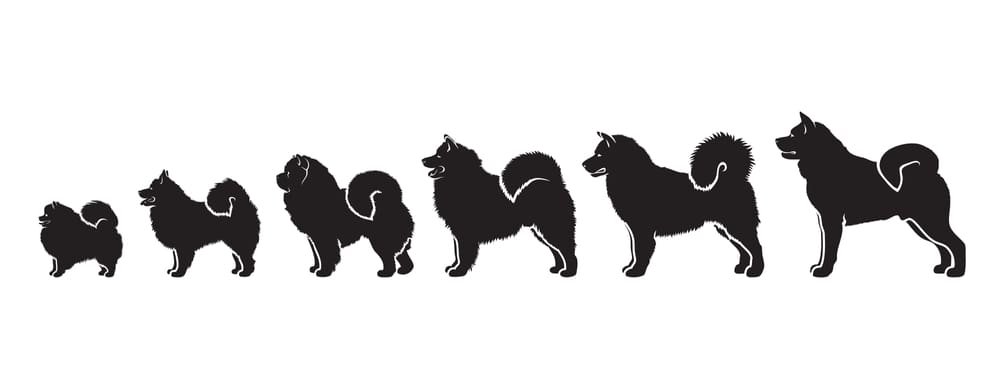Table of Contents
Are you the proud owner of a Pomeranian puppy? Are you eager to track their growth and development? Look no further than the Pomeranian growth chart – the comprehensive guide that reveals the secrets of your furry friend’s progress. From puppyhood to adulthood, this chart helps you understand your Pomeranian’s growth patterns and milestones.
In this informative article, we delve deep into the world of Pomeranian growth charts, offering you a definitive guide to unlock their fascinating secrets. Whether you’re a first-time Pomeranian owner or a seasoned pet parent, this chart is an invaluable tool to ensure your beloved companion is on the right track.
Understanding The Pomeranian Growth Chart
A Pomeranian growth chart is a powerful tool that provides insights into your dog’s development from birth to adulthood. It consists of measurements and milestones that help you understand how your Pomeranian is growing and whether they are reaching their potential. The chart typically includes measurements such as height, weight, and body length at various ages, allowing you to track your Pomeranian’s growth over time.
By comparing these measurements to the average growth rate of Pomeranians, you can determine if your dog is growing at a healthy pace. Using the growth chart effectively requires an understanding of the different growth stages and how to interpret the measurements. Let’s explore these aspects in more detail.
The Importance of Monitoring Pomeranian Growth Chart Monitoring your Pomeranian’s growth is crucial for several reasons. Firstly, it helps you ensure that your dog is developing at a healthy rate. Pomeranians, like any other breed, have specific growth patterns, and deviations from these patterns may indicate underlying health issues or nutritional deficiencies.
Secondly, tracking your Pomeranian’s growth allows you to anticipate their adult size. This knowledge is particularly important if you plan to participate in dog shows or have specific size requirements for your household. By monitoring their growth, you can make informed decisions about their diet, exercise, and overall care.
Lastly, monitoring your Pomeranian’s growth can alert you to potential growth problems or abnormalities. Some Pomeranians may experience growth spurts or delays that require veterinary attention. By regularly measuring and comparing your dog’s growth to the growth chart, you can identify any concerns early on and seek appropriate veterinary care.

How To Use a Pomeranian Growth Chart
Using a Pomeranian growth chart is relatively straightforward, but it requires consistent tracking and accurate measurements. Here are some steps to help you make the most of this valuable tool:
1. Start by obtaining a reliable Pomeranian growth chart. You can find printable charts online or consult your veterinarian for a recommended resource. Ensure the chart includes measurements for both males and females, as their growth patterns may differ slightly.
2. Record the current measurements of your Pomeranian. Measure their height from the ground to the shoulder, their weight, and their body length from the base of the neck to the base of the tail. Use a flexible tape measure for accurate results.
3. Plot the measurements on the growth chart according to your Pomeranian’s age. Most charts will have separate columns for different ages, typically in weeks or months. Connect the plotted points to visualize your dog’s growth curve.
4. Compare your Pomeranian’s measurements to the average growth rate for their age. If your dog’s measurements fall within the expected range, they are growing at a healthy pace.
However, if there are significant deviations, it may warrant further investigation. Remember to update the growth chart regularly as your Pomeranian progresses through different stages of development. This will provide a comprehensive overview of their growth and allow you to monitor any changes or abnormalities.
Factors Affecting Pomeranian Growth
Several factors can influence the growth of Pomeranians. Understanding these factors can help you interpret the growth chart more accurately and make informed decisions about your dog’s care. Here are some common factors that can affect Pomeranian growth:
1. Genetics
Genetics play a significant role in determining your Pomeranian’s size and growth rate. If your dog comes from a line of smaller Pomeranians, they are also likely to be smaller. Conversely, they may become more significant if they have more giant ancestors.
2. Nutrition
A well-balanced diet is crucial for healthy growth in Pomeranians. Ensure your dog receives adequate nutrients, including proteins, fats, vitamins, and minerals. Consult your veterinarian for the appropriate diet for your Pomeranian’s age and size.
3. Exercise
Regular exercise is essential for maintaining overall health and promoting healthy growth in Pomeranians. Engage your dog in age-appropriate physical activities to stimulate their muscles and bones. However, avoid excessive exercise, as it can strain their developing joints.
4. Health conditions
Certain health conditions can affect Pomeranian growth. Hormonal imbalances, malnutrition, and skeletal disorders can lead to stunted growth or abnormal development. Regular veterinary check-ups and appropriate healthcare can help prevent or address these conditions.
By considering these factors and monitoring your Pomeranian’s growth, you can ensure they are on track for a healthy and balanced development.
Common Growth Patterns In Pomeranians
Pomeranians, like any other breed, follow specific growth patterns as they progress from puppyhood to adulthood.
Understanding these patterns can help you interpret the growth chart more effectively and anticipate your dog’s development.
Here are some common growth patterns in Pomeranians:
- Rapid growth during the first few months: Pomeranian puppies experience significant growth during their first few months. They may double or even triple their birth weight within a few weeks. This rapid growth phase is crucial for building a solid foundation for their adult size.
- Slowing growth rate after the initial phase: As Pomeranians approach their adult size, their growth rate gradually decreases. A steady and more predictable growth pattern follows the rapid growth phase. The growth chart can help you identify when your Pomeranian transitions into this phase.
- Final adult size reached around one year: Most Pomeranians reach their full adult size by around one year of age. However, some dogs may continue to fill out and develop muscle tone until they are two years old. Monitoring their growth during this period can help you ensure they reach their genetic potential.
Understanding these growth patterns and comparing them to the growth chart can give you valuable insights into your Pomeranian’s development and help you provide appropriate care.
Tips For Promoting Healthy Growth In Pomeranians
To promote healthy growth in Pomeranians, it’s essential to provide them with the right environment, diet, and care.
Here are some tips to ensure your Pomeranian thrives during their growth stages:
Provide a balanced diet
Feed your Pomeranian a high-quality diet that meets their nutritional needs. Consider their age, size, and activity level when selecting the appropriate food. Consult your veterinarian for specific dietary recommendations.

Regular exercise
Pomeranians benefit from regular exercise, which helps develop their muscles and maintain a healthy weight. Engage them in daily walks, interactive play sessions, and mental stimulation activities. Be mindful of their energy levels and avoid overexertion.
Regular veterinary check-ups
Schedule regular check-ups with your veterinarian to monitor your Pomeranian’s growth and overall health. They can guide nutrition, vaccinations, and any concerns about your dog’s growth.
Socialization and training
Proper socialization and training are essential during growth. Introduce your Pomeranian to various people, animals, and environments to help them develop confidence and adaptability. Enrol them in puppy classes to learn basic obedience and manners.
Grooming and dental care
Pomeranians have a thick double coat that requires regular grooming to prevent matting and maintain a healthy coat. Additionally, pay attention to their dental hygiene by brushing their teeth regularly and providing appropriate chew toys.
By implementing these tips, you can provide the best care for your Pomeranian during their growth stages and set them up for a healthy adulthood.

Potential Growth Issues In Pomeranians
While most Pomeranians grow and develop without major issues, some potential growth problems can occur. Awareness of these issues can help you identify them early and seek appropriate veterinary care. Here are some common growth issues in Pomeranians:
- Slow Growth Or Failure To Thrive: Some may experience slow growth or fail to thrive despite appropriate care. Underlying health conditions, such as hormonal imbalances or malnutrition can cause this. If your Pomeranian’s growth is significantly delayed, consult your veterinarian for a thorough evaluation.
- Abnormal Bone Development: Pomeranians are prone to skeletal disorders, such as luxating patella (dislocated kneecap) or Legg-Calve-Perthes disease (hip joint degeneration). These conditions can affect average growth and require veterinary intervention. Regular monitoring of your Pomeranian’s growth can help detect any abnormalities.
- Overgrowth: In some cases, Pomeranians may experience rapid or excessive growth, leading to disproportionate body proportions. This can strain their joints and increase the risk of skeletal issues. If your Pomeranian is growing significantly faster than average, consult your veterinarian for guidance.
If you have any concerns about your Pomeranian’s growth or notice any abnormalities, it is essential to consult your veterinarian promptly. Early detection and intervention can prevent or manage potential growth issues effectively.
When To Consult a Veterinarian About Pomeranian Growth
While the Pomeranian growth chart provides valuable insights into your dog’s growth, it is not a substitute for professional veterinary advice. If you have any concerns about your Pomeranian’s growth or notice any abnormalities, it is crucial to consult your veterinarian. Here are some situations when you should reach out to a veterinarian:
- Significant deviations from the growth chart: If your Pomeranian’s measurements consistently fall outside the expected range on the growth chart, it may indicate an underlying health issue or growth problem. Your veterinarian can conduct a thorough examination and recommend appropriate tests or treatments.
- Slow growth or failure to thrive: If your Pomeranian is growing significantly slower than expected or failing to thrive despite proper care, it is essential to seek veterinary attention. This may indicate underlying health conditions that require diagnosis and treatment.
- Abnormalities in bone or joint development: If you notice any abnormalities in your Pomeranian’s bone or joint development, such as limping, difficulty walking, or signs of pain, consult your veterinarian. They can assess your dog’s musculoskeletal health and recommend appropriate interventions.
- Concerns about nutrition or diet: If you have concerns about your Pomeranian’s nutrition or diet and how it may affect their growth, seek guidance from your veterinarian. They can evaluate your dog’s dietary needs and recommend appropriate adjustments. Remember, your veterinarian is the best resource for assessing and addressing your Pomeranian’s growth concerns.
Regular check-ups and open communication with your veterinarian are essential for maintaining your dog’s health and well-being.
Resources For Tracking Pomeranian Growth
Several resources can assist you in tracking your Pomeranian’s growth and understanding the growth chart more effectively.
Here are some valuable resources to help you monitor your dog’s development:
- Online Pomeranian communities and forums: Online communities dedicated to Pomeranians often provide resources, advice, and support for Pomeranian owners. These communities can be a valuable source of information and guidance on tracking your dog’s growth.
- Pomeranian breed clubs: Pomeranian breed clubs often offer resources and educational materials for Pomeranian owners. They may provide access to growth charts specific to the breed and offer guidance on interpreting the measurements.
- Your veterinarian: Your veterinarian is the best resource for personalized advice and guidance on tracking your Pomeranian’s growth. They can provide a reliable growth chart and answer any questions or concerns.
By utilizing these resources and staying informed about your Pomeranian’s growth, you can ensure that your furry friend is on track for a healthy and happy life.
Conclusion
Maximizing Pomeranian Health through Growth Monitoring Unlocking the secrets of the Pomeranian growth chart provides valuable insights into your dog’s development and well-being. By monitoring your Pomeranian’s growth, you can ensure they are growing healthy, anticipate their adult size, and identify potential growth issues early on.
Use the growth chart to track your Pomeranian’s measurements, understand the different growth stages, and interpret their progress accurately. Consider the factors affecting the Pomeranian growth chart, promote healthy growth through proper nutrition and exercise, and seek veterinary advice when needed.
The Pomeranian growth chart is your key to unlocking the secrets of your furry friend’s growth and ensuring they receive the best care possible. With this comprehensive guide, you can confidently monitor your Pomeranian’s growth and provide them with a healthy and fulfilling life.
